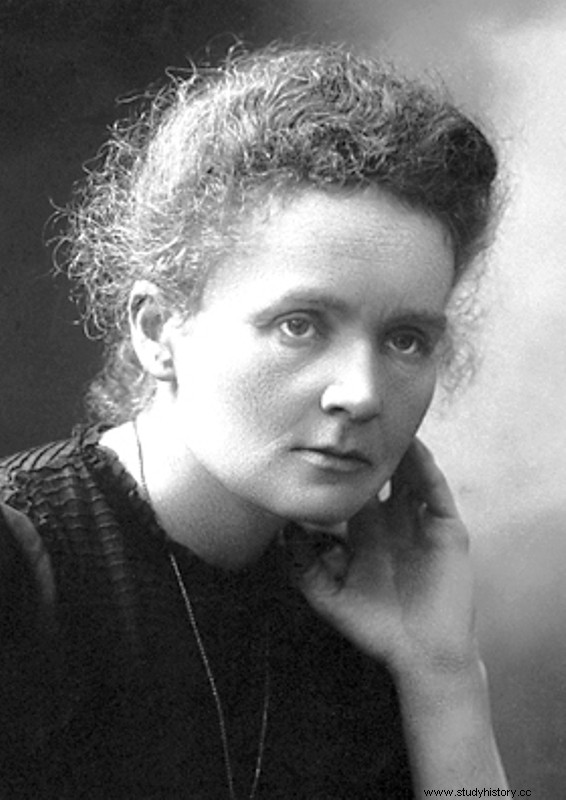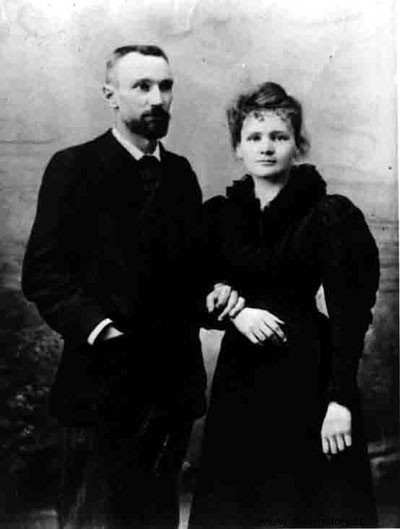Marie Curie , born Maria Salomea Skłodowska (1867 – 1934) was a French physicist and chemist of Polish origin. She is the only woman to have received two Nobel Prizes and the only one to have been awarded in two different scientific fields.
Scientific studies in Paris
 The last of a family of 5 children, Maria Salomea Skłodowska was born on November 7, 1867 in Warsaw. In her youth, she lost a sister and her mother and took refuge in studies, excelling in all subjects. She then joined the Flying University, an illegal university allowing her to study despite Russian repression, but the higher studies she wanted to do were forbidden to women.
The last of a family of 5 children, Maria Salomea Skłodowska was born on November 7, 1867 in Warsaw. In her youth, she lost a sister and her mother and took refuge in studies, excelling in all subjects. She then joined the Flying University, an illegal university allowing her to study despite Russian repression, but the higher studies she wanted to do were forbidden to women.
In 1891, Maria joined her sister Bronia who had gone to study medicine in Paris. She enrolled in physics at the Faculty of Sciences in Paris, one of 23 women (mostly foreign) among the 1,825 students. In July 1893, she obtained her degree in physical sciences by being first and, the following year, was second for her degree in mathematical sciences.
In early 1894, she joined the physical research laboratory of Gabriel Lippmann where she worked on the magnetic properties of different steels. There she meets Pierre Curie, who also works on magnetism and will work with her. Maria wanted to return to Warsaw to find her family and participate in the emancipation of Poland, but Pierre asked her to return to Paris to live with him; they married on July 26, 1895. In 1897, they had a first daughter:Irene (who was awarded a Nobel Prize in 1935).
Discovery of polonium

Marie Curie is preparing a doctoral thesis on Becquerel rays and begins to work on the study of radiation produced by uranium and examines many metals, salts and minerals containing uranium. Her results were presented on April 12, 1898. That same year, Marie Curie obtained the Gegner Prize from the Paris Academy of Sciences (which she would obtain again in 1900 and 1902).
In 1898, Pierre left aside his own work to join that of his wife; they seek to isolate from radioactive rocks the elements at the origin of the unknown radiation. On July 18, 1898, Marie Curie announced the discovery of polonium, four hundred times more radioactive than uranium. On October 26, 1900, she was appointed in charge of physics conferences at the École Normale Supérieure for secondary education for young girls in Sèvres. On June 25, 1903, she obtained the mention "Very honorable" for her thesis in physical sciences entitled Research on radioactive substances .
Two Nobel Prizes
On December 10, 1903, Marie Curie became the first woman to win a Nobel Prize, jointly with Pierre Curie and Henri Becquerel, in the physical category. The same year, she was the first woman to obtain the Davy Medal, rewarding scientists in the field of chemistry. In 1904, she gave birth to her second daughter, Eve. The Nobel Prize opens doors for the Curies; Pierre is appointed full professor of a new chair of general physics at the faculty and Marie the position of head of work for the chair.
On April 19, 1906, Pierre died in a horse-drawn carriage accident. Marie suffers from this loss but enjoys the support of her in-laws. She became the first woman in France to director of a university laboratory and encouraged the entry of female researchers or students. In 1910, she published her Treatise on radioactivity . In November 1911, she was the only woman to participate in the first Solvay Congress, physics and chemistry conferences, alongside Max Planck, Albert Einstein and Ernest Rutherford. Immediately afterwards, the discovery of her affair with the physicist Paul Langevin caused a scandal and the nationalist press was unleashed against her. On November 8, 1911, she learned that she had been chosen to receive the Nobel Prize in Chemistry for the discovery of radium and polonium; despite the scandal and despite the committee's suggestion, she travels to pick him up.
Institut Curie
That same year, 1911, work began on the creation of a Radium Institute, dedicated to medical research against cancer (the future Institut Curie); it was completed in 1914, and Marie Curie directed the physics and chemistry laboratory). When war broke out, Marie mobilized like many others; it designs mobile surgical units and, from 1916, goes to the front to perform x-rays. His daughter Irène, who is 18, accompanies him there. At the end of the war, Marie resumed her work at the Radium Institute, with her daughter as an assistant.
During the 1910s, Marie began to suffer from health problems (especially in the eyes and ears) due to excessive exposure to radioactive elements. As early as 1920, she thought that radium could play a role in her health problems. Suffering from leukemia, she continued her work at the Radium Institute. On June 29, 1934, she was hospitalized and died on July 4.
